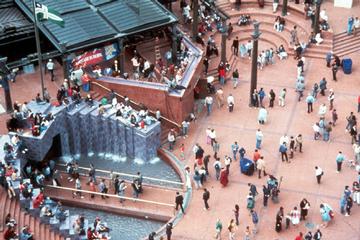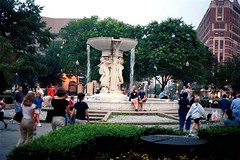Making Places
 Pioneer Courthouse Square, Portland, Oregon. PPS photo.
Pioneer Courthouse Square, Portland, Oregon. PPS photo.It's already the end of the month and I haven't mentioned the excellent December issue of the online Making Places e-magazine from the Project for Public Spaces. This issue is about "Making Public Squares" and is fabulous, as usual.
Check out in particular "Ten Principles for Creating Successful Squares," which lays out advice based on a whole lot of experience. The ten principles:
1. Image and Identity
2. Attractions and Destinations
3. Amenities
4. Flexible Design
5. Seasonal Strategy
6. Access
7. The Inner Square & the Outer Square
8. Reaching Out Like an Octopus
9. The Central Role of Management
10. Diverse Funding Sources
In "The 16 Squares Most Dramatically in Need of Improvement," two Washington places, Education Plaza (of course) and Dupont Circle (huh?) come in for some doses of "tough love." For Dupont Circle, the primary point is that the spaces that make up the Circle are disconnected, and there are gaps (e.g., have you ever noticed how dirty the street is north of the Circle on Connecticut?). [I don't know why they didn't pick up on my idea to rename "L'Enfant Plaza" to "Urban Brutalism Plaza?"]
 Dupont Circle. Photo copyright by Dick Hodgman. (Photo best seen large.)
Dupont Circle. Photo copyright by Dick Hodgman. (Photo best seen large.)From the article:
Many think DuPont Circle is the best destination in Washington. We think it is performing at 30% of its potential. The city has undergone a metamorphosis in the past ten years, with many areas gradually becoming more vital. However, there seems to be a limit to this improvement: a rigid adherence to a master plan that keeps many areas from coalescing into real destinations. DuPont Circle needs to be freed from that mold. There are active parts of the Circle, but they are not connected. The Farmers Market is separate from the inner circle and from the active part of Massachusetts Avenue. The road around the Circle is two lanes too wide, and the connections from the interior park to the edges could be dramatically improved. With Connecticut Avenue running underneath the circle, there is no need to cater to heavy traffic. In fact, DuPont Circle could become a traffic-calmed, pedestrian friendly destination and quite possibly the core of a great urban district. Fulfilling this tremendous opportunity is essential if Washington is to become a world class city.
No DC public square was rated highly enough to be written about in the article "Top 12 Public Squares in the U.S. and Canada," and these are the kinds of independent metrics that need to be added to the kinds of performance statistics tracked to measure municipal improvement (i.e., how many independent businesses created, small business employment, how many businesses make the INC 500 list or the Black Enterprise list of growing minority businesses, does at least one of your public spaces make the list of the best places by the Project for Public Spaces, etc.).
And like I have finally come around to the use of the word "gentrification," I agree with Fred Kent's use of the word "placemaking" rather than "urban design." Using the word "placemaking" keeps people and places front and center, not the dictates of "design," which can allow a designer to stray from the focus on place and context. (Now I just have to go back and redo my index keywords.)
 Pioneer Courthouse Square, PPS photo.
Pioneer Courthouse Square, PPS photo.Index Keywords: urban-design



0 Comments:
Post a Comment
<< Home